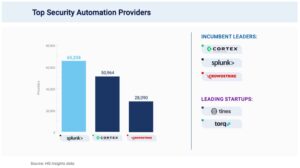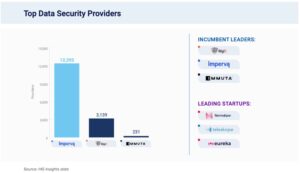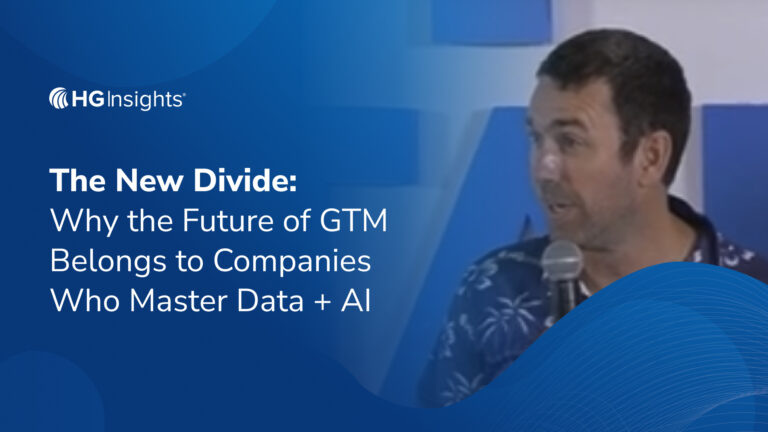The cloud security market is on the rise. Over the past five years, global cloud spending has surged to 68% of Total External IT spend. In 2023, it’s crucial to understand the cloud security market size, growth, and competitive landscape.
Driven by an increasing need for data protection and the migration of businesses to cloud security, large enterprises and major players are making substantial investments in this market. Microsoft generated a remarkable $20 billion in Annual Recurring Revenue (ARR) from security products alone in 2022. Meanwhile, Google spent nearly $6 billion acquiring vendors like Mandiant and Siemplify, and AWS introduced new data security offerings.
HG Insights took a deep look at our proprietary data to unpack the state of cloud security and found immense potential for disruption. Discover the global cloud security spend, market leaders, disruptive startups, and key investment areas for 2023. From IAM to AppSec, Security Automation, and Data Security, explore the evolving landscape and future opportunities in cloud security.
The Global Cloud Security Market Size & Outlook

Cloud security has become a significant investment priority for organizations worldwide, with market size reaching an impressive $76 billion. According to HG Data, the AMER region leads the pack and the U.S.-based companies account for 38% of the total global spend, emphasizing the country’s dominance in this sector.

In terms of global distribution, the top 10 countries investing significantly in cloud security are the USA, China, Japan, UK, Germany, India, Canada, France, South Korea, and the Netherlands. The United States holds the foremost position, investing a staggering $29.5 billion to fortify its cloud infrastructure. China secures the second spot with a total expenditure of $8.9 billion, highlighting its commitment to cloud security.
Among industries, finance leads in cloud security spending, allocating a substantial $23.4 billion to protect its critical assets and sensitive data. Public administration demonstrates a strong commitment to cloud security with $14.5 billion in spend, and manufacturing follows closely behind, investing $11.5 billion.
2023 Cloud Security Market Leaders and Categories to Watch
Today, four cloud security categories have emerged as highly sought-after and pivotal to the future of the market: Identity and Access Management (IAM), Application Security (AppSec), Security Automation, and Data Security, are witnessing tremendous demand and innovation. Within these categories, both incumbents and up-and-comers have emerged as clear, cloud security market leaders. We found immense potential for disruption.
“There are two ways to compete in cloud security as a non-incumbent or a disrupter,” explains Rak Garg, Principal at Bain Capital Ventures. “The first way is to reinvent something existing in a way that’s 10 times better. The second way is to find an emerging architecture, surface area, or workflow that no one else is doing well, and focus on that.”
Identity Access Management (IAM)
Identity and Access Management (IAM) helps businesses protect digital identities and manage user access to resources, applications, and data in the cloud. IAM encompasses two-factor authentication, single sign-on systems, multi-factor authentication, and access management, all aimed at fortifying access control.

While Sailpoint pioneered IAM solutions in 2005, now, it trails industry leaders such as Microsoft, AWS, Okta, and Cisco in terms of customer count. Additionally, startups like Opal and ConductorOne are gaining traction in the market.
Looking ahead, we expect a shift toward a more dynamic and just-in-time authorization approach. Driven by machine learning analysis of historical access patterns and resource sensitivity, this evolution will enable businesses to implement more granular and context-aware access controls, enhancing overall cloud security.
Application Security (AppSec)
Application security (AppSec) involves identifying, fixing, and preventing security vulnerabilities in software and hardware, and the development of those processes. AppSec covers the whole application lifecycle and manages an application’s posture from code to runtime.

According to HG data, Palo Alto Networks currently dominates the AppSec market with a customer base more than double the size of its closest competitor, Aqua Security. Leading startups, Resourcely and Jit, are making notable strides in the industry. In the future, we expect to see AppSec in closer collaboration with AppDev, focusing on identifying and addressing errors early in the software development lifecycle.
“An ideal developer security platform would unify vulnerabilities from code to runtime, finding a medium between being too broad (false negatives) and too granular (false positives),” Garg said.
Security Automation
Security automation involves the automated detection of possible security breaches and responds by correlating and acting on security events and logs. With the proliferation and advancement of AI, security automation exponentially increases security productivity while reducing human assistance (and error).

Leading security automation providers are closely vying for dominance in 2023. However, the market is expanding and presenting ample growth opportunities. The future of security automation lies in the realm of holistic automation, where products are predicted to offer low and/or no-code workflows that bridge security, IT, HR, and engineering functions.
“Specialized functions like security are slowed by a mountain of manual work and human intervention,” Garg says. “Market sizes in each vertical are expanding as companies seek the benefits of automation in more processes.”
Data Security
Data security safeguards organizational data to mitigate unauthorized access and data exfiltration risk and ensure that authorized individuals within the organization have uninterrupted access. It encompasses protective measures against various attacks that aim to encrypt, destroy, modify, or corrupt data.

In 2023, Imperva dominates the data security market with the largest customer base, surpassing its closest competitor, BigID, with nearly four times the amount of buyers. In a remarkable feat, Imperva’s DDoS mitigation solution successfully defended a Chinese telecom customer against a massive four-hour attack involving over 25.3 billion requests, setting a new record.
As AI continues to advance, the risk and potential for data breaches also grow. To address this, we anticipate the emergence of developer-friendly data access and security workflows that proactively limit the risk of breaches before they happen — such solutions would enhance data security in an increasingly challenging landscape.
Download The 2023 Cloud Security Market Report
Get more data-driven insights into the cloud security market in HG Insights’ 2023 State of Cloud Security Market Report. Our free market reports are designed to give you a high-resolution view of your distinct market to empower your Go-To-Market strategy and accelerate business growth.
HG Insights gives sales and marketing teams a competitive advantage in finding and acquiring new customers, building advanced scoring models, getting proactive notification of sales cycles, and spotting churn before it happens. If our solutions seem like a good fit for your business — schedule a demo with one of our solutions engineers! We’re happy to walk you through the platform, so you can see our Technology Intelligence for yourself.





